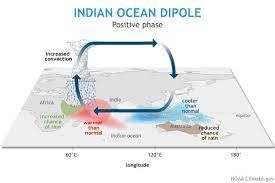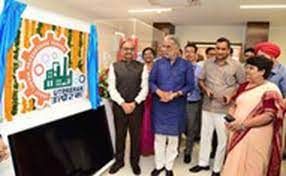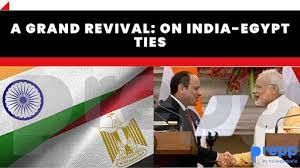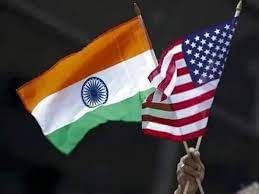UPSC Daily Current Affairs- 29th June 2023 | Current Affairs & Hindu Analysis: Daily, Weekly & Monthly PDF Download
| Table of contents |

|
| GS-I |

|
| About UTPRERAK: |

|
| GS-II |

|
| About Rajya Sabha: |

|
| GS-III |

|
| About Report Fish Disease App: |

|
GS-I
Indian Ocean Dipole

Why in News?
With the El Nino phenomenon almost certain to affect the Indian monsoon this year, high hopes are pinned on the development of a positive Indian Ocean Dipole (IOD) and its ability to counterbalance the El Nino effect.
About
- While El Nino is already firmly established in the Pacific Ocean this year, the IOD is still in the neutral phase.
- According to the India Meteorological Department (IMD), the probability forecast for IOD indicates about 80% probability for positive IOD conditions and 15% of a neutral IOD during June-August 2023 season.
- All international climate models surveyed also suggest a positive IOD event may develop in the coming months.
Indian Ocean Dipole
- The IOD is an ocean-atmosphere interaction very similar to the El Nino fluctuations in the Pacific Ocean, playing out, as the name shows, in the Indian Ocean.
- It is also a much weaker system than El Nino, and thus has relatively limited impacts.
- But a positive IOD does have the potential to offset the impacts of El Nino to a small measure in neighbouring areas, and it has, at least once in the past (1997), delivered admirably on this potential.
- How?
- IOD, sometimes referred to as the Indian Nino, is a phenomenon similar to ENSO, playing out in the relatively smaller area of the Indian Ocean between the Indonesian and Malaysian coastline in the east and the African coastline near Somalia in the west.
- One side of the ocean, along the equator, gets warmer than the other.
- Positive & Negative IOD:
- IOD is said to be positive when the western side of the Indian Ocean, near the Somalia coast, becomes warmer than the eastern Indian Ocean.
- It is negative when the western Indian Ocean is cooler.
- Relations of ENSO & IOD:
- A positive IOD event is often seen developing at times of an El Nino, while a negative IOD is sometimes associated with La Nina.
- During El Nino, the Pacific side of Indonesia is cooler than normal because of which the Indian Ocean side also gets cooler. That helps the development of a positive IOD.
- Many studies suggest that IOD events are actually induced by ENSO.
- But according to others, IOD events can have an independent existence.
- A positive IOD event is often seen developing at times of an El Nino, while a negative IOD is sometimes associated with La Nina.
- Impact of IOD:
- A positive IOD helps rainfall along the African coastline and also over the Indian sub-continent while suppressing rainfall over Indonesia, southeast Asia and Australia. The impacts are opposite during a negative IOD event.
El Niño
- El Niño is the warming of seawater in the central-east Equatorial Pacific that occurs every few years.
- In a normal year
- The eastern side of the Pacific Ocean, near the northwestern coast of South America, is cooler than the western side near the islands of Philippines and Indonesia.
- This happens because the prevailing wind systems that move from east to west sweep the warmer surface waters towards the Indonesian coast.
- The relatively cooler waters from below come up to replace the displaced water.
- An El Nino event is the result of a weakening of wind systems that leads to lesser displacement of warmer waters.
- This results in the eastern side of the Pacific becoming warmer than usual.
Outcomes
- Disruptions in the food chain: The phenomena of upwelling, where nutrient-rich waters rise towards the surface, is reduced under El Niño. This in turn reduces phytoplankton.
- Thus, fish that eat phytoplankton are affected, followed by other organisms higher up the food chain.
- Disruptions in the overall ecosystem: Warm waters also carry tropical species towards colder areas, disrupting multiple ecosystems.
- Alterations in wind & weather patterns: Since the Pacific covers almost one-third of the earth, changes in its temperature and subsequent alteration of wind patterns disrupt global weather patterns.
- El Niño causes dry, warm winters in the Northern U.S. and Canada and increases the risk of flooding in the U.S. gulf coast and southeastern U.S. It also brings drought to Indonesia and Australia.
La Niña
- La Niña is the opposite of El Niño. La Niña sees cooler than average sea surface temperature (SST) in the equatorial Pacific region.
- Trade winds are stronger than usual, pushing warmer water towards Asia.
- On the American west coast, upwelling increases, bringing nutrient-rich water to the surface.
- Pacific cold waters close to the Americas push jet streams — narrow bands of strong winds in the upper atmosphere — northwards.
- This leads to drier conditions in the Southern U.S., and heavy rainfall in Canada.
- La Niña has also been associated with heavy floods in Australia. Two successive La Niña events in the last two years caused intense flooding in Australia, resulting in significant damage.
ENSO
- Both these conditions, together called El Nino Southern Oscillation or ENSO, affect weather events across the world.
Way ahead
- Compared to ENSO events, the impacts of IODs are much weaker.
- But, hope lingers, including this year when a strong El Nino is expected to develop in the Pacific Ocean.
Source: TH
What is UTPRERAK?

Why in News?
Recently, the Union Minister of State for Power inaugurated UTPRERAK, a dedicated Centre of Excellence to accelerate industry adoption of clean technologies in New Delhi.
About UTPRERAK:
- The Unnat Takniki Pradarshan Kendra (UTPRERAK) is the Centre of Excellence to Accelerate Adoption of Energy Efficient Technologies and seeks to play a catalytic role in improving the energy efficiency of the Indian industry.
- It is also named as Advanced Industrial Technology Demonstration Centre (AITDC)
- It has been set up by the Bureau of Energy Efficiency (BEE), Ministry of Power.
What are the mandates?
- The Centre is mandated to become the key reference and resource institution on industrial energy-efficient technologies.
- It will demonstrate and showcase energy-efficient technologies in key industry sectors.
- It will act as an exhibition cum information centre and knowledge repository.
- It will be a knowledge exchange platform, where best practices from across various key sectors could be diffused among industry professionals through workshops and seminars.
Key facts about the Bureau of Energy efficiency
- It is a statutory body under the Union Ministry of Power.
- It was set up under the provisions of the Energy Conservation Act, of 2001.
- Mission: Develop policy and strategies with a thrust on self-regulation and market principles within the overall framework of the Energy Conservation Act (EC Act), 2001.
- Primary Objective: To reduce energy intensity in the Indian economy.
Source: The Hindu
GS-II
A grand revival: on India-Egypt Ties

Why in News?
Recently, the Indian Prime Minister (PM) has visited Egypt for the first time since 1997 to discuss bilateral relations between India and Egypt.
About India-Egypt Ties:
Historical Background:
- India-Egypt relations can be traced back to 2750 BCE when the Pharaoh Sahure sent ships to the “Land of Punt,” believed to be peninsular India.
- The exchange continued, with Egyptian mummies wrapped in Indian indigo-dyed muslin in the second millennium BCE.
Friendship Treaty and bilateral relations:
- The two nations became even closer in the 1950s and concluded a historic Friendship Treaty in 1955.
- During the last couple of years, the traditionally strong bilateral relations enjoyed by the two countries have received an impetus with regular exchange of high-level meetings and contacts between the two sides.
Economic Relations:
- Since March 1978, the India-Egypt Bilateral Trade Agreement has been in effect, operating under the Most Favoured Nation clause.
- In the fiscal year 2018-19, the bilateral trade reached a value of US$ 4.55 billion.
- Despite the challenges posed by the pandemic, the volume of trade only experienced a slight decline to US$ 4.5 billion in 2019-20 and further decreased to US$ 4.15 billion in 2020-21.
- Notably, the bilateral trade between India and Egypt reached a record high of US$ 7.26 billion in the fiscal year 2021-22.
- Major Egyptian exports to India include: Raw cotton, raw and manufactured fertilizers, oil and oil products, organic and non-organic chemicals, leather and iron products.
- Major imports into Egypt from India are: Cotton yarn, sesame, coffee, herbs, tobacco and lentils.
- Mineral fuel; vehicle parts; Ship, boat and floating structure; cuts of boneless bovine frozen meat; and Electrical machinery and parts are also exported from India.
Defense Cooperation:
- The two Air Forces collaborated on the development of fighter aircraft in the 1960s, and Indian pilots trained their Egyptian counterparts from the 1960s until the mid-1980s.
- Both the Indian Air Force (IAF) and Egyptian air force fly the French Rafale fighter jets.
- In 2022, a pact was signed between the two countries that have decided to also participate in exercises and cooperate in training.
- The first joint special forces exercise between the Indian Army and the Egyptian Army, “Exercise Cyclone-I” was completed in January 2023 in Jaisalmer, Rajasthan.
Science and Technology:
- ‘Science and Technology’ cooperation is implemented through biennial Executive Programmes and Scientific Cooperation Programme between CSIR (India) and NRC (Egypt).
- The 2nd ISRO-NARSS JWG was held in Cairo in 2017.
- The India-Egypt Workshops on Agriculture-Biotechnology and Nanotechnology were held in Shillong in 2018 and in Mumbai in 2019 respectively.
- An IT Centre in Al Azhar University, CEIT, is also operational since February 2019.
Cultural Links:
- The Maulana Azad Centre for Indian Culture (MACIC) was set up in Cairo in 1992.
- It aims to promote cultural cooperation between the two countries, through the implementation of the Cultural Exchange Programme (CEP).
- The Centre, in addition to popularizing Indian culture through Hindi, Urdu and Yoga classes and the screening of movies, also organizes cultural festivals.
- ‘India by the Nile’ festival:
- It is a cultural festival celebrated annually in Egypt.
- It brings the essence of India through classical, contemporary, performing and visual arts, food and popular culture in a language that amalgamates diverse cultural and artistic strands.
- The festival is produced by Delhi-based M/S Teamwork Arts and supported by ICCR and the Egyptian Ministry of Culture.
Challenges of India Egypt Relations:
- Political differences: There have been differences on key international issues. For instance, Egypt has not always shared India’s position on the United Nations Security Council (UNSC) reforms.
- Regional instability: Egypt’s geographical location in North Africa places it in proximity to several unstable regions and conflict zones, including Libya and Sudan.
- This instability can indirectly impact India-Egypt relations by creating uncertainties in areas of mutual interest such as regional security and economic investment.
- Navigating regional politics: Both India and Egypt have complex regional relationships to navigate.
- Balancing these relationships, particularly as they pertain to issues such as Kashmir for India or the Israeli-Palestinian conflict for Egypt, could pose challenges.
- China’s growing influence: China’s growing economic presence in Africa, including Egypt, is another significant challenge.
- China’s Belt and Road Initiative has been making significant inroads in Africa and this has increased China’s influence in the region.
- Balancing relations with China while trying to increase India’s economic engagement in Egypt and the broader African region could be a tricky diplomatic challenge for India.
Way Forward:
Bolstered by historical ties, and buffeted by present-day geopolitical turmoil, it is clear that India and Egypt are now essaying a closer relationship, one that looks both at future economies and autonomous foreign policies.
Source: The Hindu
How are Rajya Sabha Members Elected?

Why in News?
The Election Commission of India recently announced the schedule for the election on 10 Rajya Sabha seats in Goa, Gujarat and West Bengal.
About Rajya Sabha:
- Origin: India follows the British parliamentary system, so the Rajya Sabha, or the Upper House of Parliament, is equivalent to the House of Lords in the United Kingdom.
- Present strength: The Rajya Sabha currently has 245 members, including 233 elected members and 12 nominated. As per the constitutional limit, the Upper House strength cannot exceed 250.
- Membership: While 233 members are elected from states and Union Territories (UTs), President of India nominates the remaining 12 from from the fields of art, literature, science and social services.
- Tenure: Every Rajya Sabha MP has a tenure of six years and elections to one-third seats are held every two years.
- Vacancy: According to Section 154 of the Representation of the People Act 1951, a member chosen to fill a casual vacancy will serve for the remainder of his predecessor's term of office.
- Chair: The Indian vice-president is chairperson of the Upper House, while it also has a deputy chair.
Election Process to Rajyasabha:
- While Lok Sabha members are elected directly by the voters, Rajya Sabha members are elected indirectly by the people, that is, by the elected Members of a state's Legislative Assembly (MLAs).
- How many Rajya Sabha members a state can send depends on its population.
- MLAs vote in the Rajya Sabha elections in what is called proportional representation with the single transferable vote (STV) system. Each MLA’s vote is counted only once.
- In this system, MLAs don’t vote for each seat.
- Instead, the MLAs are given a paper with the names of all candidates. They have to give their order of preference for each candidate, marking 1,2,3… against their names.
- The ballot is open but MLAs have to show their ballots to an authorised agent from their party to prevent practices such as cross-voting. A vote cannot be counted if the ballot is not shown to the agent. Independent MLAs cannot show their ballot to anyone.
- If a qualifying number of voters choose a candidate as their first choice, he or she is elected.
- The remaining votes go to the next candidates, but with a lesser value. So, MLAs also vote for candidates from other parties.
- The candidate that gets rank 1 from an MLA secures a first preference vote. In order to win, a candidate needs a specific number of such first preference votes. This number depends on the strength of the state Assembly and the number of MPs it sends to Rajya Sabha.
- To win, a candidate should get a required number of votes which is known as quota or preference vote. The formula is = [Total number of votes/(Number of Rajya Sabha seats + 1)] + 1.
- However, the formula is changed in case more than one seat needs to be filled. The total number of votes required for a candidate in the case is = [(Number of votes x 100) / (Vacancies + 1)] + 1.
Source: Indian Express
Status of India-U.S. Technology Trade

Why in News?
Technology was a major focus of PM Modi’s recent U.S. visit but U.S tech firms are sceptical about digital trade with India.
Status of India-U.S. technology trade
- In FY2023, the U.S. emerged as India’s biggest overall trading partner with a 7.65% increase in bilateral trade to $128.55 billion in 2022-23.
- However, digital or technology services did not emerge as one of the sectors at the forefront of bilateral trade.
- Digital trade is also the area where some of the biggest U.S. tech companies have recently flagged multiple policy hurdles, including “India’s patently protectionist posture”.
Initiatives
- The India-U.S. have been ramping up their tech partnership through moves like the Initiative on Critical and Emerging Technology (iCET) announced by President Joe Biden and Prime Minister Narendra Modi in 2022.
- Under the iCET, India and the U.S. agreed to cooperate on critical and emerging technologies in areas including artificial intelligence, quantum computing, semiconductors and wireless telecommunication.
- The ambitious MoU signed between the two states on the Semiconductor Supply Chain and Innovation Partnership, which includes a combined investment valued at $2.75 billion.
- On the telecommunications front, the two leaders launched two Joint Task Forces to focus on the Open RAN network and research and development in 5G/6G technologies.
Concerns of U.S. tech firms
- The Washington D.C.-headquartered Computer & Communications Industry Association (CCIA) flagged policy barriers to trading with India .
- According to CCIA ,the U.S. ran a $27 billion deficit in trade in digital services with India in 2020”.
- The U.S.’s extension of market access, trade and openness to Indian companies to operate and succeed in the U.S. has not been reciprocated by the Indian side.
- The Indian government has deployed a range of “tools to champion their protectionist industrial policy”, tilting the playing field away from U.S. digital service providers in favour of domestic players.
- To describe these “discriminatory regulation and policies”, it cites the example of India’s guidelines on the sharing of geospatial data, which it accuses of providing preferential treatment to Indian companies.
- It has also expressed discontent over India’s veering away from “longstanding democratic norms and values, and seeking greater government censorship and control over political speech”, which it argues has made it “extremely challenging for U.S. companies to operate in India”.
- Taxation measures :The equalisation levy, when it was first introduced in 2016, led to double taxation and further complicated the taxation framework. Besides, it also raised questions of constitutional validity and compliance with international obligations.
- The 2020 amendment again led the levy to become sweeping and vague in its scope.
- India’s IT Rules 2021: The Information Technology (Intermediary Guidelines and Digital Media Ethics Code) Rules, 2021, has been flagged by the consortium of foreign tech firms under some of the most “problematic policies”.
- New draft of the data protection law: Ambiguities about cross-border data flows, compliance timelines, and data localisation still remain.
- The CCIA contends that the draft Telecommunications Bill, 2022, has a sweeping regulatory ambit .
- The Parliamentary Committee on Finance proposed the adoption of a “Digital Competition Act”.
- It would include estimated taxes for big or significant digital intermediaries, arguing that the proposal appeared “to be largely targeted at U.S. tech companies”.
Future Outlook
- The two countries are bullish on future tech such as AI and Quantum Computing, having put in place the Quantum Coordination Mechanism and a joint fund for the commercialization of Artificial Intelligence.
- India-US partnership has been one of equals both at the people and trade levels.
- Both should maximise the opportunity without sacrificing strategic autonomy. Be it geopolitics or trade relations.
Source: TH
GS-III
Report Fish Disease App

Why in News?
Union Minister for Fisheries, Animal Husbandry and Dairying will launch the Report Fish Disease(RFD) App at Krishi Bhawan New Delhi.
About Report Fish Disease App:
- It will strengthen the farmer-based disease reporting system and for improving the reporting of aquatic animal diseases in the country.
- The app has been developed by ICAR-NBFGR under National Surveillance Programme for Aquatic Animal Diseases (NSPAAD).
- Funded under: Pradhan Mantri MatsyaSampadaYojana by the Department of Fisheries, Ministry of Fisheries, Animal Husbandry and Dairying, Government of India.
What are the benefits?
- It will help the farmers in reporting the incidence of diseases in finfish, shrimps, and molluscs on their farms with the field-level officers and fish health experts.
- This shall help farmers in getting scientific advice for the efficient management of the disease.
- The data regarding the diseases will be stored on temporal & spatial scales and can be used for mapping the disease cases.
- It would support farmers in improving farmer-based reporting, getting scientific advice, and reducing losses due to diseases, thereby increasing farmers’ income.
Key Facts about Pradhan Mantri MatsyaSampada Yojana
- It is a flagship scheme for focused and sustainable development of the fisheries sector in the country with an estimated investment of Rs. 20,050 crores for its implementation during a period of 5 years from FY 2020-21 to FY 2024-25 in all States/Union Territories.
- What are the aims of the scheme?
- It aims at enhancing fish production by an additional 70 lakh tonnes by 2024-25.
- Increasing fisheries export earnings to Rs.1,00,000 crore by 2024-25.
- Doubling of incomes of fishers and fish farmers, reducing post-harvest losses from 20-25%.
- Nodal Ministry: Ministry of Fisheries, Animal Husbandry and Dairying
Source: The Hindu
Greedflation

Why in News?
There is a growing consensus across the world that corporate greed is spiking inflation even as workers are doubly penalized by low wage increases and higher interest rates.
About Greedflation:-
- Greedflation simply means (corporate) greed is fuelling inflation.
- It is the phenomenon where corporate greed becomes a significant factor in fueling inflation.
- It implies that companies exploited the inflation that people were experiencing by putting up their prices way beyond just covering their increased costs.
- This was then used to maximize their profit margins.
Disadvantage:-
- The increased prices may further contribute to inflationary pressures in the economy.
- It disrupts the traditional understanding of the wage-price spiral and emphasizes the influence of corporate behavior on inflation dynamics.
- Excessive price hikes by companies contribute to an inflationary cycle, exacerbating the overall inflation levels.
Effects of Greedflation:-
- Greedflation in non-essential products: the consumers can simply opt to go without that particular item or service because it is not a necessity.
- Greedflation on a wide scale: its impact will be similar to traditional inflation.
- Consumers may not be able to avoid the higher prices because they genuinely need the affected products or services.
Greedflation and India:-
- The Indian corporate sector has generated superlative profits in the post-pandemic period.
- Profits during recent times have been nearly thrice the profits corporates earned earlier.
- The Higher profits than can come from:-
- Higher sales (with the same profit margins).
- Higher profit margins (with the same level of sales).
- Or a combination of higher sales and higher profit margins.
Source: Indian Express
|
38 videos|5339 docs|1131 tests
|















